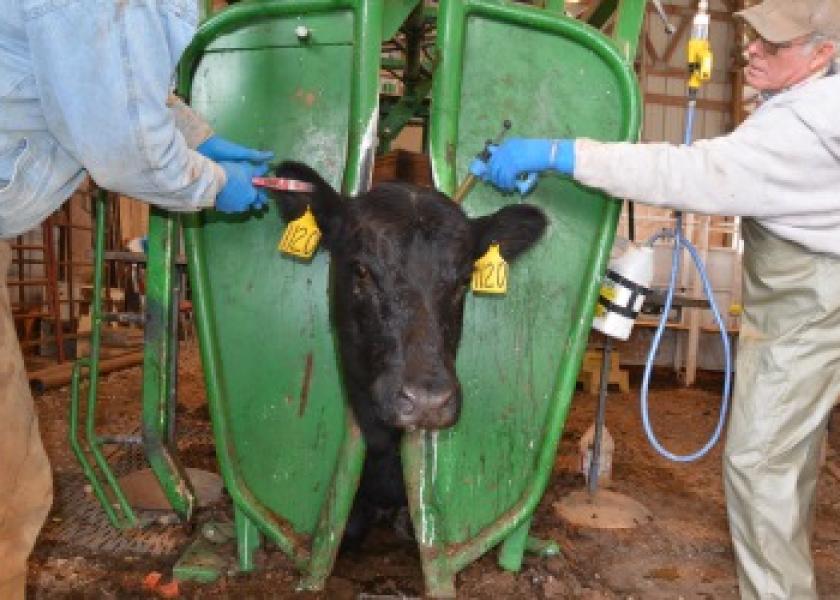Get to Know Bovine Leptospirosis

Bovine Leptospirosis can be costly and deadly disease for cattle producers to deal with.
By: Lew Strickland, Extension Veterinarian, University of Tennessee
Leptospirosis, commonly referred to as ‘Lepto’, is an economically important disease caused by the spiral-shaped bacteria Leptospira, which has over 200 subclassifications called ‘serovars’. Some examples of different serovars include hardjo, pomona, canicola, icterohaemorrhagiae, and grippotyphosa, all of which are included in the commonly used ‘5-way Lepto’ vaccines. There are specific vaccines produced to protect against the serovar hardjo alone. Serovars are typically associated with one or more maintenance hosts that serve as reservoirs of infection. Maintenance hosts can be wildlife species, domestic animals, and livestock. An animal may be infected by serovars maintained by its own species (maintenance host infection) or serovars maintained by other species (incidental infection).
Clinical Signs
The clinical signs associated with leptospirosis vary depending on the serovar and the age of the animal. When leptospirosis occurs in calves, the result is high fever, jaundice, and sometimes death in 3 to 5 days. In older cattle, the initial symptoms such as fever and lethargy are often milder, and usually go unnoticed. In addition, older animals usually do not die from leptospirosis. Lactating cows produce less milk, and for a week or more the milk they produce is thick and yellow. However, unlike many other udder infections, leptospirosis does not usually cause any firmness of the udder. Leptospirosis also affects pregnant cows causing infertility, embryonic death, abortions, stillbirths, retained placenta, and the birth of weak calves. Abortions usually occur 3 to 10 weeks after infection.
Cattle are the maintenance host for serovar hardjo, and therefore infection with this serovar can produce a carrier state in the kidneys associated with long-term urinary shedding. In addition, infections with serovar hardjo can cause persistent reproductive tract infections. The infertility that results from the persistent reproductive tract infections is perhaps the most economically damaging aspect of leptospirosis in the southeastern United States.
Transmission
Leptospirosis is transmitted either directly between animals or indirectly through the environment. The Leptospira organism is most commonly shed in the urine of an infected animal, thus infecting animals directly or contaminating the environment. The source of infection can therefore be an infected animal or water/feed that has been contaminated with infected urine. The organisms gain entry to the body though the membranes of the eyes, nose, mouth, and even the skin, especially if it is injured or water-softened. Maintenance hosts also commonly shed the bacteria in placental fluids and milk. In addition, some Leptospira serovars can be transmitted venereally.
Leptospira organisms can survive in the environment for weeks to months depending on environmental conditions, and some organisms have been shown to survive in stagnant, standing water or in wet soil for months if the temperature is favorable (between 50° and 93°F). Moisture and warm temperatures are conducive to Leptospira survival, while dry, freezing, and extremely high temperatures often kill the bacteria.
Zoonosis
“Lepto” is also a zoonotic disease. Humans are exposed in a similar manner as cattle by entry to the body though the membranes of the eyes, nose, mouth, and injured skin. There are several reports of ranchers and veterinarians becoming infected after exposure to fluids from infected animals. So, wearing protective clothing and gloves during calving assistance is of the upmost importance to reduce exposure to this disease.
Treatment and Prevention
Due to the high prevalence of Leptospira carriers, both cattle and wildlife, avoiding all exposure to leptospirosis is not possible for most beef cattle operations. Your veterinarian may prescribe antibiotic therapy for animals with leptospirosis. However, attempting to prevent leptospirosis through regular herd vaccination is the best approach. At a minimum, annual vaccination of bulls, cows, and replacement heifers prior to the breeding season with a ‘5-way Lepto’ vaccine is recommended. Work with your veterinarian and local Extension agent to develop a biosecurity/vaccination protocol for your farm.







